



| Species Name | Killer whale |
| Japanese Name | Shachi |
| Scientific Name | Orcinus orca |
| Height | Male about 9m, female about 7m |
| Weight | Male about 7t, female about 4t |
| Distribution | In most oceans around the world |
From the tropics, to the Arctic and the South Poles, they are one of the most widely distributed cetaceans. Their diet is just as varied, eating large cetaceans & seals, seabirds, fish, and squid, depending on their environment. The size of males are overall much larger, with a higher dorsal fin than females. Also the males have wider and larger pectoral fins than females, making them more easily distinguishable.
Currently, the scientific name is "Orcinus orca," but it is wildly accepted that killer whales have different physical characteristics and distinct ecologies geographically, so there is a possibility that they might end up being divided into multiple groups or subspecies in the near future.
The smallest group of killer whales is called a family group (or sub-pods) centered on the mother whales and their calves, and a gathering of several sub-pods form a larger pod, which are a family group. Each pod has its own voice repertoire, and it is observed that whale females other than the mothers, commonly play with calves which means as a collective, they are supporting each other to raise the children. When a calf is very young, the mother lifts and supports the baby's body from below, to ensure that the child can breathe air reliably. It has also been observed that they will take the same actions to support companions in the pod who are in a weakened state and cannot breathe. Through this, we can see that whales are deeply affectionate animals.
 Killer whale pod (June photo)
Killer whale pod (June photo)Based on observation records taken since 2006, killer whales on the coast of Shiretoko Rausu has gradually been increasing. Currently it has the highest rate of encounters with Killer whales in the waters around Japan. Nearly 200 killer whales per year, can be seen, with sightings peaking between May and June. Specifically, in the area around Rausu, each pod has an average of 11 individuals, and often there is a high number of immature whales in the pods. Whale calves are less weary of people and being very curious, they may often approach the ship to investigate. Young calves can be identified by the white parts on their body having a yellowish tint. Thanks to this youthful curiosity, there is a better chance to see natural behaviors such as breaching and spy hops as a closer distance.
 Spy hopping killer whale (June photo)
Spy hopping killer whale (June photo)

| Species Name | Sperm whale |
| Japanese Name | Makkou kujira |
| Scientific Name | Physeter macrocephalus |
| Height | Male about 18m, Female about 11m |
| Weight | Male about 45t Female about 15t |
| Distribution | From the topics to the ice edges of both hemispheres |
Sperm whales are in the family of toothed whales, holding the record for having the largest teeth on the planet. Just 5 km off the coast of Rausu, there is a deep-sea dropoff with a depth of more than 1000m, where the sperm whales prey on deep-sea squid and other sea life.
Sperm Whales get their name from the brain oil, which resembles sperm, and fills their characteristic giant head. The head alone can make up a quarter to one-third of the whale's body. There is also a theory that this brain oil, which is usually a liquid, can become more solid when it is cooled to change the specific gravity. This enables the whales to adjust their buoyancy during diving and ascents. It is also notable that all the whales that come to the Nemuro Strait are male sperm whales.
Physically, male whales are larger and there are distinct differences in population distribution between the males and females. Female whales will form a pod of closely related female whales, staying in the warm waters at lower latitudes, such as the Ogasawara Islands. The pod will raise their calves together. The female calves eventually remain in the mother's pod as adults, but as the male calves grow, they will leave the mother's pod and gradually move to higher latitudes with other male whales of the same generation. As they grow, the pod gets smaller as the older males split off to be on their own, with eventually only a single whale or two remaining. Occasionally, they return to the warm waters with the female whales to breed, and will breed across multiple pods of females. For this reason, there are basically no female whales along the coast of the Shiretoko Peninsula, but you can see the larger, more dynamic male sperm whales.
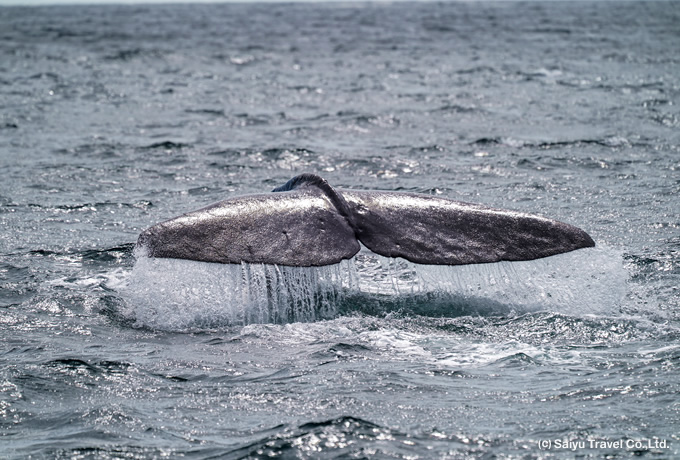 A sperm whale's 'Fluke Up' (August Photo)
A sperm whale's 'Fluke Up' (August Photo)While searching for sperm whales, you scan for the 'blow'. A 'Blow' is the air that has been warming inside of a whale and it is released when the whale emerges at the surface. It becomes a mist when exposed to the cold atmosphere. Like other toothed whales, it has one blowhole, but for sperm whales, it is usually located on the left side. Therefore, if you see a blow that is spraying out diagonally from the water, it is likely a sperm whale. They surface, breathe and as they dive, their tail fin rises high up on the sea surface and then disappears into the deep sea.
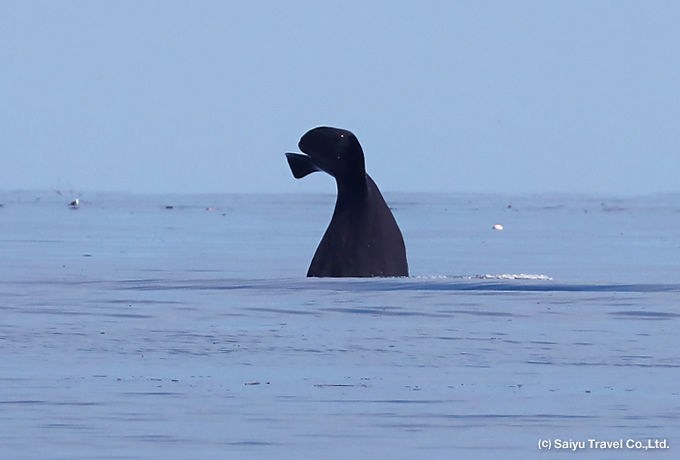 Diving with the tail fin high (August Photo)
Diving with the tail fin high (August Photo)
The Shiretoko River is special because many salmon species will swim to and from the sea using the river. Cherry salmon (In Japanese, Sakura Masu) begin to go upstream around May, and will spawn upstream from August to September. The pink salmon (Karafuto Masu) go upstream from mid-August to October and numbers peak in September. Chum salmon (Shirozake) start going upstream from September to January of the following year and usually peak in October.
The salmon leave the river a few months after hatching, enter the sea and migrate to the Northern Pacific waters. The salmon that have grown in the ocean will eventually return to the Shiretoko river, where they were born. As soon as they begin their migration upstream, the skin of the breeding salmon becomes reddish. The skin thickens to protect them from the rocks and the scales become a hard armor. In males, the upper jaw protrudes covering the lower jaw, resulting in a condition called "hooked noses."
The brown bears eat the migrating salmon, storing up vital fat reserves for their long hibernation. Smaller animals such as birds and foxes also eat the salmon, and the uneaten parts decompose to nourish the soil and help the forest grow. The abundant nutrients from the sea and drift ice end up being transported in large quantities through the salmon and trout, to enrich the land. The Ainu people called the salmon "Kamuichep" (God of Fish). Just as the name indicates, the salmon are an integral part of the nutrient chain in Shiretoko.

Shiretoko is the world's southernmost destination of drift ice, but why is that? The simple answer is the Sea of Okhotsk. Surrounded by the Kamchatka Peninsula, the Kuril Islands, and Hokkaido, the water depth is relatively shallow, and the water rarely mixes with the nearby ocean currents. When a large amount of fresh water flows from the Amur River in Russia, it forms a layer on the surface of the sea that is low in salt content. Then, when a cold monsoon called the "Siberian High" blows on this layer, it is said that seawater freezes at a higher temperature than usual which forms the drift ice.
On the Shiretoko Peninsula, this can be observed from the end of January to about the end of March annually. The Utoro cliffs are also thought to have been etched by the smashing drift ice which eroded the shore. Drift ice is a unique seasonal feature of Shiretoko in the winter and especially popular to be observed from the sightseeing boats. In Rausu, a cruise at dawn where you can see the rising sun from Kunashiri Island is highly recommended.
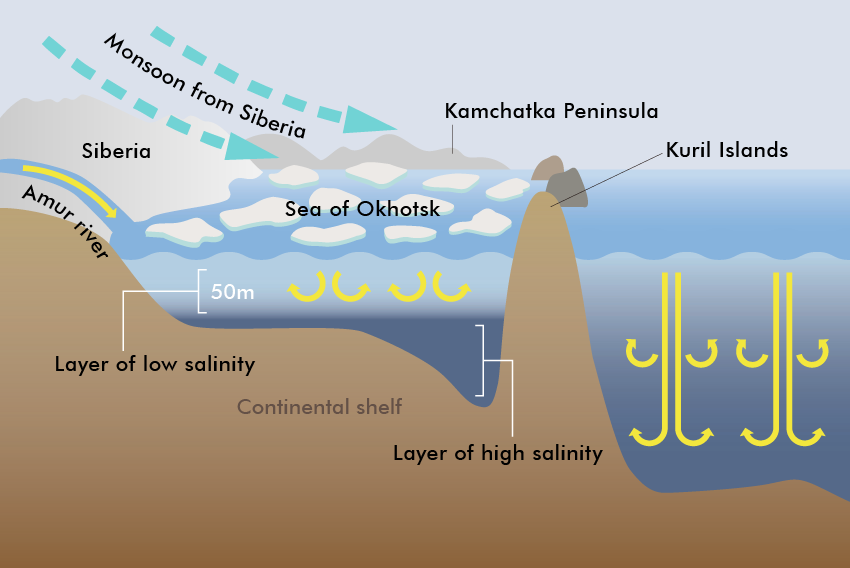 Diagram: How drift ice is formed
Diagram: How drift ice is formed
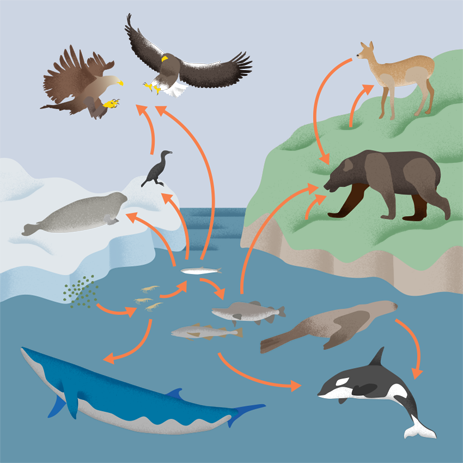 Come spring, just under the drift ice is a phytoplankton called "ice algae," which starts to rapidly increase as the drift ice starts to melt. This attracts many zooplankton which come to feed on them, and then their population explodes. This in turn attracts small fish, such as anchovy, which flock to feed on this zooplankton, which attracts the cetaceans such as dolphins and whales to feed on these smaller fish. When whale and dolphin carcasses drift to the beach, bears and birds of prey will then feed on them. These land animals also feed on the salmon and trout migration in the fall as well. In this way, starting with the bears and other land animals, the nutrients of the sea are transported to the land, and then the cycle goes on and on.
Come spring, just under the drift ice is a phytoplankton called "ice algae," which starts to rapidly increase as the drift ice starts to melt. This attracts many zooplankton which come to feed on them, and then their population explodes. This in turn attracts small fish, such as anchovy, which flock to feed on this zooplankton, which attracts the cetaceans such as dolphins and whales to feed on these smaller fish. When whale and dolphin carcasses drift to the beach, bears and birds of prey will then feed on them. These land animals also feed on the salmon and trout migration in the fall as well. In this way, starting with the bears and other land animals, the nutrients of the sea are transported to the land, and then the cycle goes on and on.
These nutrients from the sea, taken in by these terrestrial animals, becomes excrement and feed the forest, and these valuable nutrients become the food for many plants. Some of plant nutrients will be then again, eaten by the animals (as leaves and berries) or wither and are decomposed by bacteria in the soil. These plant nutrients will then dissolve into the rivers and eventually flow into the sea. In this way, the cycle of nutrients from the forest will eventually be a source of life for the ocean.
From drift ice to the sea, rivers, and then the terrestrial world, a dynamic food chain connects everything together. This magnificent cycle of life is very much alive in Shiretoko.




 Taking photos of killer whales in Nemuro Strait
Taking photos of killer whales in Nemuro Strait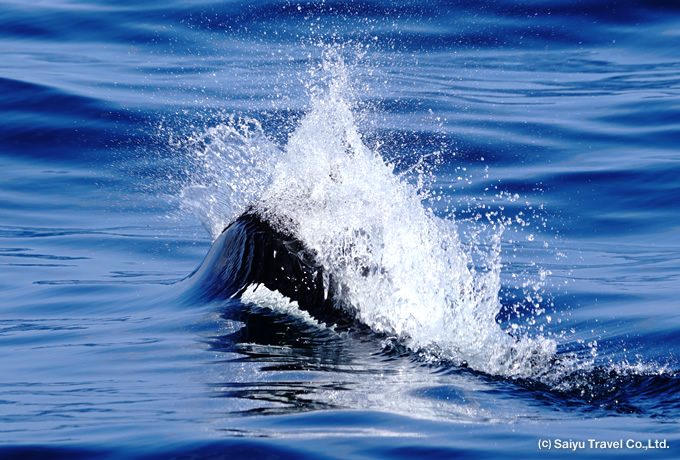 Occasionally Pacific White-sided Dolphins and Dall's porpoise can be seen
Occasionally Pacific White-sided Dolphins and Dall's porpoise can be seen

*These are wild animals, so there are no guarantees of their appearance and changes in weather conditions and the local environment will affect the wild animal's behavior.
*The arrival of drift ice is strongly affected by temperatures, wind and ocean currents, so optimal viewing times may vary.